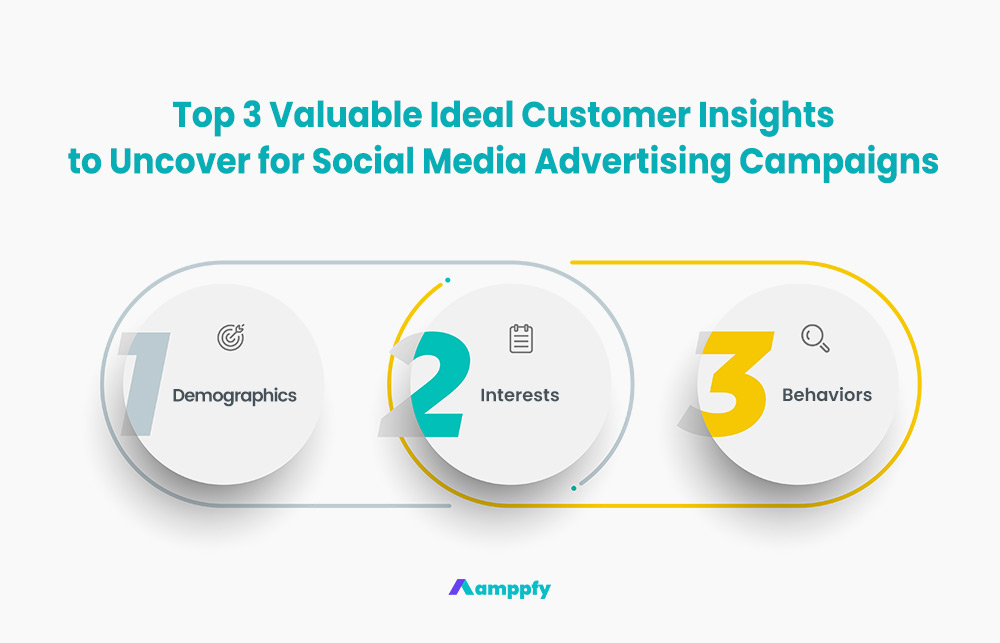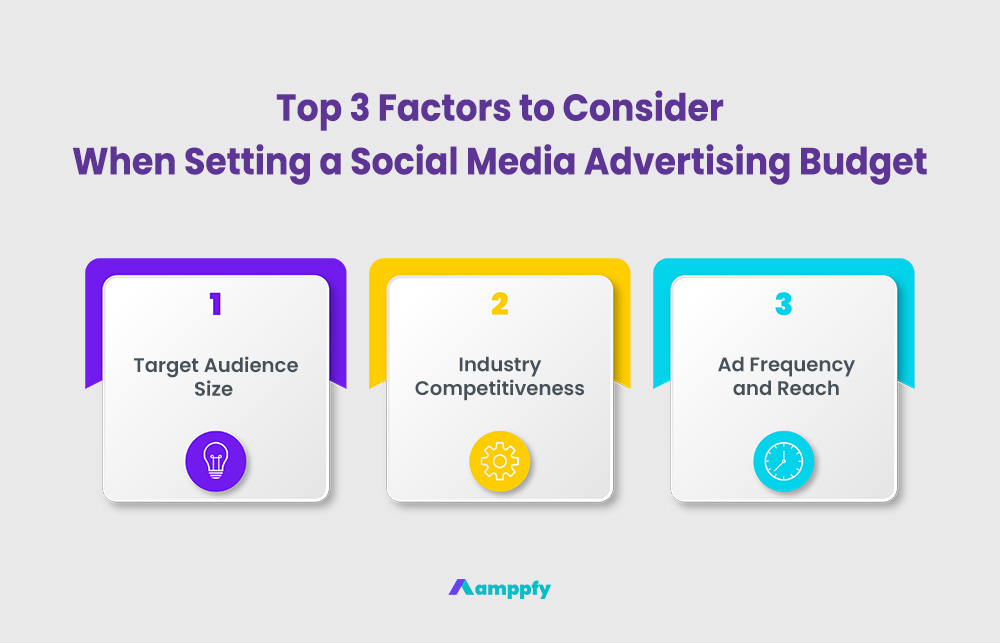Let’s walk through the process of starting a social media advertising campaign that maximizes return on investment (ROI) and targets the right ideal customer profile (ICP).
Identify The Right Target Audience for Your Social Media Advertising Campaigns
Identifying your ICP when launching a social media advertising campaign is crucial. Understanding your ideal customers helps you better tailor content and advertising messages to resonate with them. Begin identifying the target audience by researching the industry, competitors, studying the market, and analyzing competitor strategies. Pay attention to the following customer insights.
Top 3 Valuable Ideal Customer Insights to Uncover for Social Media Advertising Campaigns

- Demographics
- Interests
- Behaviors
For example, let’s say your business is in the fitness industry, and the target audience may consist of primarily young adults interested in health and wellness. Uncovering this data enables content creation that appeals to potential customers’ specific interests and values.
Demographic Audience Targeting for Social Media Advertising Campaigns
Social media platforms like Facebook and Instagram provide powerful targeting options to reach specific demographics. These platforms offer detailed customer insights and tools to narrow down the target audience. By utilizing these targeting options, you can minimize unnecessary ad spend and ensure the campaigns reach the right personas.
For instance, if you are a fashion brand primarily targeting female audiences, you can set parameters such as age, gender, location, and interests to ensure the campaign is shown to your desired audience.
Understanding Audience Preferences for Better Social Media Advertising Campaigns
Once you have narrowed down the ideal target audience group, you can craft more impactful campaigns that drive engagement and conversions. Understanding your target audience’s preferences, pain points, and aspirations allows you to personalize the ad messages and create a more meaningful experience that resonates on a deeper level.
For example, if the target audience is environmentally conscious, highlight the sustainable practices of your business and emphasize how your products or services align with their values. This approach is an effective strategy to gain traction while building trust and customer loyalty.
Establish Clear Goals for Social Media Advertising Campaigns
To measure the success of a social media advertising campaign, it is essential to establish clear objectives from the start by answering the following three questions.
Top 3 Questions to Establish Clear Goals for Social Media Advertising Campaigns
- Is the goal to increase brand awareness?
- Is the goal to drive more website traffic?
- Is the goal to generate more leads or sales?
Defining realistic goals and objectives helps establish metrics to track and evaluate the performance of the social media advertising campaign.
Defining SMART Goals for Social Media Advertising Campaigns
Set SMART goals that align with the overall marketing objectives to help accurately measure and track the ROI of social media advertising campaigns.
What are SMART Goals, and What Does SMART Stand For?
- S: Specific
- M: Measurable
- A: Achievable
- R: Relevant
- T: Time-bound
Conduct Market Research to Understand Your Target Audience on Social Media
There are several factors to consider when establishing clear objectives for social media advertising campaigns. Start with establishing a solid understanding of the target audience, their demographics, and preferences.
Research Customer Demographics for Social Media Advertising Campaigns
Conducting market research and analyzing customer demographics deliver valuable insights into what the customers are looking for and how to effectively reach them through social media. It is also important to align your research goals with the overall marketing strategy to ensure that the social media advertising efforts are integrated seamlessly, creating a cohesive and impactful brand presence across multiple channels.
Analyze Competitor’s Social Media Advertising Strategies
Analyzing competitor social media strategies provides insights into the competition level as well as what works and what doesn’t in the industry. This information helps you set realistic goals and differentiate your brand from the competition.
Set Specific and Measurable Objectives for Social Media Advertising Campaigns
Establishing specific and measurable objectives instead of having a vague goal like “increase brand awareness” sets a more precise benchmark to measure progress and determine the success of your social media advertising campaign. Consider defining a specific target, such as increasing brand mentions by 20% or gaining 1,000 new followers in three months.
Achievability and relevance are also key factors when defining ad campaign objectives. Setting unrealistic goals often leads to disappointment and frustration, so make sure that the goals are attainable within the resources and capabilities of your business. Measurable and specific goals should contribute to the growth and success of your business in the long term.
Create Achievable Deadlines for Social Media Advertising Campaigns
Time-bound objectives create a sense of urgency to help you stay on track. Set specific deadlines for achieving ad campaign goals, whether it is increasing website traffic by a certain percentage or generating a particular number of leads within a defined time frame. The time-bound approach is a great way to evaluate campaign effectiveness within a predefined period.
Set a Reasonable Budget for Social Media Advertising Campaigns
One of the advantages of social media advertising is its cost-effectiveness compared to traditional advertising channels. However, setting a reasonable budget that aligns with your business needs is still essential. Consider the following.
Top 3 Factors to Consider When Setting a Social Media Advertising Budget

- Size of the target audience
- Competitiveness of the industry
- The desired reach and frequency of the ad campaigns
Factor #1. Social Media Advertising Budget Based on Target Audience Demographic Data
When determining the size of your target audience, it is necessary to understand the demographics, interests, and behaviors of the potential customers. Then, estimate the number of people you want to reach with the ad campaign. This information is critical to defining and allocating an appropriate budget to deliver the ad messaging to the right audience.
Factor #2. Social Media Advertising Budget Based on Industry
An industry’s competitiveness also plays a significant role in budgeting for social media advertising. If you operate in a highly competitive market, a larger budget may be needed to stand out from the competition. On the other hand, if your business is in a less saturated niche market with fewer competitors, you might be able to achieve the same advertising goals with a more modest budget.
Factor #3. Social Media Advertising Budget Based on Ad Frequency
Ad frequency determines how often the target audience sees an ad and how many impressions you aim to generate. This is key to controlling the budget required to achieve the desired level of exposure. Start with a smaller budget when launching a new social media advertising campaign to test the effectiveness of the ad messaging and make any necessary adjustments before investing a significant amount of money.
Increase Social Media Advertising Budget Steadily When Results are Proven with Campaign Strategy
As you begin to observe positive results and a good return on investment (ROI), gradually increase the ad budget and closely track campaign outcomes. Do understand that more budget does not guarantee better results. Continuously monitor the ad performance and analytics data to improve your future ad budgeting decisions.
Choose the Right Social Media Advertising Platforms
Choosing the right social media platform to run ads is imperative for campaign success. Select the ad platform and campaign format that best serves your business needs and yields optimal results. Consider the following.
Top 3 Considerations when Choosing the Right Social Media Advertising Platform
- Facebook and Instagram are widely used platforms that offer robust advertising options and audience targeting capabilities.
- LinkedIn is ideal for B2B marketing and raising brand awareness.
- TikTok can be effective for targeting younger demographics.
Craft Engaging Content on Social Media
Developing a long-term content strategy helps you craft engaging content that resonates with your core audience and aligns with the brand messaging. Create attention-grabbing headlines, compelling visuals, and concise ad copies that clearly communicate the brand’s value proposition. To capture attention and drive engagement, experiment with different content formats, such as images, videos, and carousel ads. Remember to test and optimize the content based on the feedback and performance data you receive.
Analyze Performance and Making Adjustments for Social Media Advertising Campaigns
Regularly analyzing the performance of ad campaigns and making data-driven adjustments is a vital step for maximizing ROI. Leverage the analytics provided by each social media platform to monitor key metrics.
Top 4 Key Metrics for Analyzing Social Media Advertising Campaigns
- Impressions
- Clicks
- Conversions
- Engagement rates
Identify trends and patterns in the data to understand what resonates with your audience. Based on these insights, make necessary adjustments to the ad targeting, ad creative, and budget to optimize the campaign’s performance.
To further maximize social media advertising campaign results, see our complete guide on how to run a social media audit.
Measuring Social Media Advertising Campaign ROI
Tracking and attributing conversions accurately helps to measure the ROI of your social media advertising campaigns. Set up conversion tracking using tools like Facebook Pixel or Google Analytics to gauge the impact of the ad performance.
Top 5 KPI Metrics to Measure Social Media Advertising Campaign ROI

- Website visits
- Sign-ups
- Purchases
- Form fills for leads
- Business model specific call-to-actions (CTAs), such as account creation
Assign a value to each conversion to calculate the return on your ad spend and analyze the following KPI metrics to understand the true impact of the social media advertising efforts.
Top 5 KPI Metrics to Access Social Media Advertising Campaign Impact
- Cost-Per-Acquisition (CPA)
- Cost-Per-Click (CPC) or Pay-per-click (PPC)
- Cost-Per-Thousand Impression (CPM)
- Return-On-Ad-Spend (ROAS)
- Overall revenue generated
As a last note, if your business has a local market presence, check out our guide on how to boost your social media campaign results and ROI by leveraging the power of hyperlocal social media marketing.

